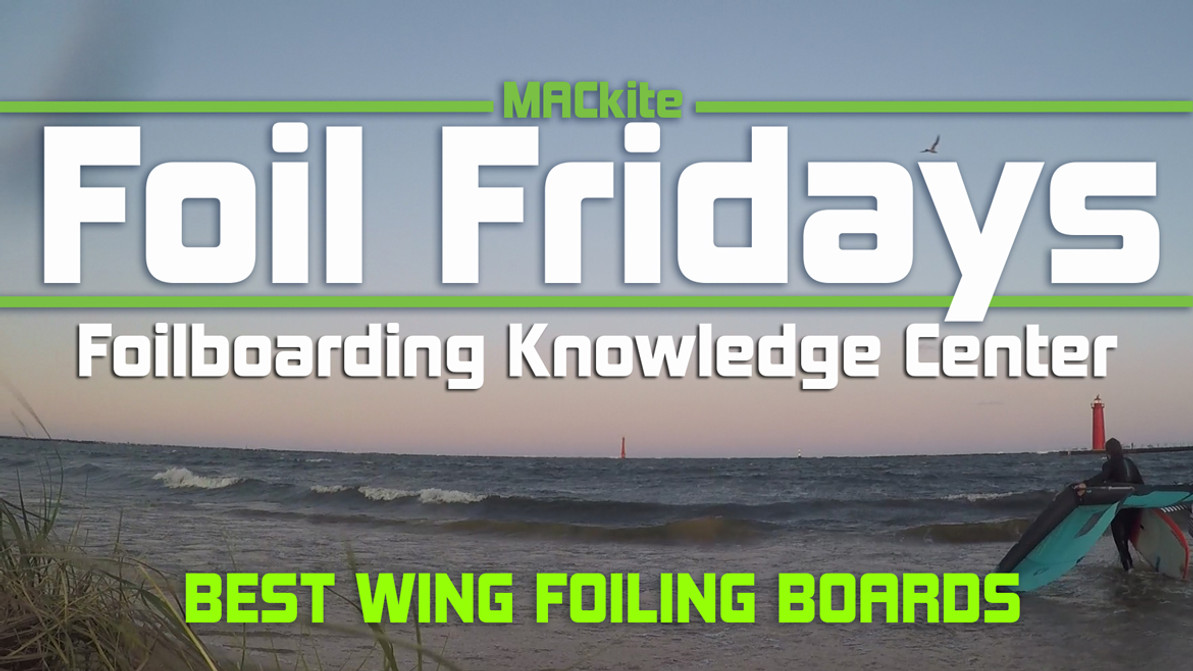Foil Fridays - The Best Boards & Features For Wing Foiling Part 1
Wing foiling, wing surfing, hand kite, wing ding.... whatever you call this hot new sport, everyone wants to talk about it but not many people have firsthand knowledge. We have been fortunate enough to have gotten some prototypes in late spring from most of our brands, and I can tell you we are hooked, although we were skeptical at first, thinking it might be too difficult, need tons of wind, or just get boring after the novelty wore off.

After a couple sessions, progressing past the learning curve and getting some long rides, I can tell you that we were hooked. Wing foiling is not as fast as kiteboard foiling or windsurf foiling and it needs a bit more wind, but the simplicity, accessibility, and freedom is undeniable. After playing in some small waves, I can tell you that my stoke is on record high level for our larger down-winding swell this fall. I love surf and SUP hydrofoiling in waves, but the downtime waiting for waves and the limitation of breaking waves keeps you waiting more than riding. The wind wings give you the ability to choose waves and start to ride them far before they would be catch-able on another craft. After your ride ends, either by a mistake you made or the necessity to drive back upwind (yes they do go upwind), you simply change directions and blast back out into the lineup to do it again. Want the basics of how to get started? Check out our blog about that...
https://www.mackiteboarding.com/news/foil-fridays-how-to-wing-surf-foil-first-steps-and-tips/
Now kiters, I know you already know this benefit and can ride with less board, faster speeds, and ride upwind at significantly harder angles, but when you are on the wave, you are slave to the kite line tension and pull. On a kite or windsurfer, you cannot easily ride a wave directly upwind, directly downwind, or match wave speed easily; it takes honed skills, the correct conditions, and perfect gear choice. Even the most seasoned professional is limited by the kite in their wave riding freedom. The benefit of wing foiling in waves is that you can get a true surf foil experience on the wave with little consideration for the wing. This is done by simply holding the leading edge and letting it luff (float) downwind. The wind in the sail is enough to keep it weightless; you just need to hold on and keep it steady enough to not tumble in your hand. Disclaimer here: if you are riding powerful waves directly downwind in a lighter wind scenario, you may need two hands to hold the kite up and balance it since you can easily match wind-speed on foil when riding downwind and negate its power in the canopy.
This video and blog is a two-part series and we will discuss the best hydrofoils for Wing Foiling next week, so tune in.

Board Features for Wing Foiling
At a beginner level, all notable wings will get the job done if you have the right size and wind-speed; it's your intended progression that will help determine the best fit for you. I'll touch on this on another video and blog soon. In the meantime, feel free to contact us at the shop for a personalized recommendation.
On the other hand, the board you choose will have a huge effect on your learning curve, progression, wind range, and potential performance. The wrong board choice can be detrimental to your learning and progression.
Size
As most board-riders know, size does matter. This is especially true for wing foiling. You need enough buoyancy to float your weight, enough stability to stand on the board. The easy answer would be to simply buy the largest board, however that will have an adverse effect on your riding experience as well. A larger board, while easier to stand on, will be harder to lift off the water, more difficult to maneuver, and hard to handle in waves.
As always, feel free to contact us for a personal recommendation, but most riders will find that the proper size board will be similar in volume to their surf paddle boards or similar in width to their standard do-it-all boards, only at a lower volume.
For instance, if you ride a 110 liter surf paddleboard with dimensions 6'8x27x4", a SUP foilboard with 110 liters of volume and dimensions 6'0x28.5x4.2" should be a good fit.
Similarly, if you have a "do it all" longboard style SUP that is 175 liters with dimensions 11'0x31x4.5", a SUP foilboard of 125 liters would be a good choice with dimensions 6'5x32x4.2". Less volume, but the boxy design, flat rocker, and foil mast add stability as well as the directional stability that the wing will provide.
Sizes and recommendations range by design but If you are an average skilled board-rider, this will give you a place to start...
100-140 lbs - 90-110L board
140-190 lbs - 95-120L board
190-250 lbs - 110-150L board
If you can manage it, a shorter board will pump up easier due to the reduced surface tension (suction) on the front of the board. In addition to added maneuverability, the short and wide design also results in a better acceleration curve to build speed for liftoff due to its lower aspect ratio and reduced drag.

Kicktail
The kicktail was designed for paddle foilboarders to rock the board onto foil with less effort and drag. Straight tailed boards act like a brake in the water when you attempt to rock the foil up. For paddle-board hydrofoilng in waves, it is a nice feature to have but it is even more beneficial for wing foiling. This is because it takes longer to accelerate to flying speed with wind power than a breaking wave's power. An experienced foiler can begin pumping this way before they reach their flying speed by removing the drag and surface tension of the board so that you can reach that speed more quickly and make good use of gusts.
Footstrap mounting inserts
Footstrap or foot hook mounting inserts are a good feature to have on your board, even if you are not at that level yet. If you are going to invest in a board, it's nice to know that it will support your progression beyond your first steps. Having footstraps allows the rider more leverage and a more secure connection to the board. This is especially important for hard maneuvering, jumps, and larger boards or foils that need more force to react.
We recommend riders new to strap-connected hydrofoiling use foot hooks or a loose front strap first to reduce injury, and also to move your rear foot to adapt to varying speeds and adapt riding position for less fatigue.

Our favorite boards
Our favorite boards for Wing Surfing thus far have been the Naish Hover SUP Foil in Sandwich Carbon and Slingshot Outwit. Both boards are purpose built for foiling, have excellent construction, and have a range of sizes to meet most riders' needs.
The Hover is offered in...
95L 5'7 x 27" x 4.3"
110L 6'0 x 28.5" x 4.2"
125L 6'5 x 31" x 4.2"
https://www.mackiteboarding.com/2020-naish-hover-sup-foil-foilboard/
The Outwit is offered in...
100L 5'10 x 25" x 5.2"
120L 6'6 x 28.5" x 4.4"
140L 7'6 x 28.7" x 4.6"
https://www.mackiteboarding.com/2019-slingshot-outwit/
Written and produced by Tucker Vantol and Ryan (Rygo) Goloversic
Tucker Vantol
Mackite's resident surf and "Hydrofoil junkie." You can either catch him on the phones or on the water at dawn testing new gear. He is proficient at a myriad of sports, a shaper and passionate about getting his water time. When he discovered kiteboarding it took over as his predominate sport. The same could be said about hydrofoiling.
Recent Posts
-
Light Wind Kiteboarding Magic? The Reedin WhisperModel Might Be the Answer
Jeff from MACkite had a chance to meet up with Kevin Langeree of Reedin in Cape Town, South Afri …22nd Apr 2025 -
Hot New Releases: MACkite Brand Parawing & Mystic Majestic Ex Custom Harness
MACwing v.5 Beta Single Skin Single Use Jake and Ryan from MACkiteboarding unveiled an excit …1st Apr 2025 -
Code Foils 1250R, with Josh Ku and James Casey | Training, Gliding, and Light Wind Downwinding
Introduction: The Rise of the 1250R The Code Foils 1250R is the latest and largest addition to Co …1st Apr 2025




